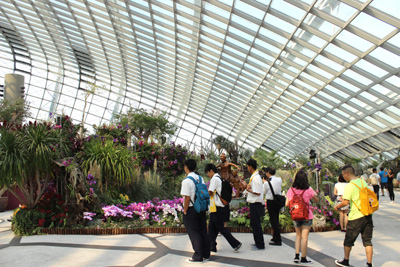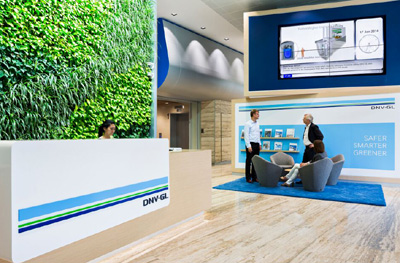Singapore has seen remarkable successes after starting its green building movement a decade ago, sharing valuable experience to other countries in the region to follow sustainability efforts in the built environment.
“Through Building and Construction Authority’s Green Building Masterplans and the Green Mark scheme, bold targets and initiatives were articulated, and comprehensive measures were laid out to spur the building and development sector towards being greener. BCA also fostered close collaborations with the industry to drive progress and push the boundaries. Today, close to a third of the nation’s building stock have already been greened, totaling about 70 million square metres of total gross floor area,” remarked Mr Choi Shing Kwok, Permanent Secretary, Ministry of the Environment and Water Resources, at the opening ceremony of the International Green Building Conference (IGBC) 2015 host by BCA on September 2-4 at Marina Bay Sands with more than 1,000 participants from over 30 countries.
.jpg)
Gardens by the Bay Overview (Photo: Gardens by the Bay)
Mr Quek See Tiat, Chairman of BCA which champions the development of an excellent built environment for Singapore, noted: “2015 marks a full decade of sustainability efforts in the built environment since we launched the BCA Green Mark scheme. To date, we have more than 2,500 green building projects in Singapore; that is almost 29% of the nation’s buildings stock. We are also seeing a growing number of Green Mark certifications for non-building developments too. So far, more than 150 tenants have been certified under the various Green Mark occupant-centric schemes.”
According to Mr Choi Shing Kwok, later this year, the United Nations Framework Convention on Climate Change Conference of the Parties (or UNFCCC COP21) will take place in Paris, and Singapore hopes to see all countries agreeing to create a new post-2020 agreement to reduce global carbon emissions. Singapore has submitted its Intended Nationally Determined Contribution (or INDC) in July with the intention to reduce our emissions intensity by 36% from 2005 levels by 2030, and to stabilize emissions with the aim of peaking around that some time, he added. “This is a tough commitment for Singapore to meet, but it is in our opinion a necessary one.”
To fulfill this commitment, the built environment sector will have an important role to play. Constructing and operating buildings and infrastructure are undoubtedly energy and carbon intensive activities. In fact, in cities worldwide including Singapore, buildings contribute to about a third of all global greenhouse gas emissions, and make up nearly 40% of global energy consumption. The sector must therefore continue to demonstrate leadership in pursuing sustainability efforts.
“While Singapore has enjoyed a successful decade of leadership in sustainability, we must continue these efforts and spur even more stakeholders to improve building energy efficiency and further reduce energy consumption. To do so, we can further leverage on technologies to generate new solutions and overcome constraints,” said Mr Choi Shing Kwok.
Efforts on International Front
On the international front, BCA’s efforts have been recognized through accolades such as the International Star of Energy Efficiency Award in 2013. BCA has also been working closely with the United Nations Environment Programme (UNEP) to support the development of green building policies in the South East Asia region.
Separately, more than 270 building developments in 75 cities from 14 countries have applied for the BCA Green Mark certification to date.
For the IGBC this year, BCA has also partnered with the respective Green Building Councils of Australia, China, India and Indonesia. Together, with the active participation of the Singapore Green Building Council (SGBC), we have enhanced the regional focus of the conference programme.
To better apply its green mark practices overseas, BCA has signed Memorandum of Understanding with its partners in region countries, including China, India, Sri Lanka, Indonesia and Myanmar, to share and engage the international community and industry players in the areas of green buildings.
Launches of green building initiatives
On the occasion, BCA of Singapore announced new green building initiatives with the aim of going beyond the decade of leadership in sustainability.
1, The BCA Green Mark 2015 is a green building rating system for new building (non-residential), with a greater emphasis on health, and wellbeing and smart technologies.
Green Mark aims to recognize a sustainable built environment whilst driving sustainability outcomes enabling us to develop a high quality built environment and sustainable growth for our current and future generations. They include climate responsiveness, resource stewardship, health & wellbeing, and conservation of ecological systems.
2, The BCA SkyLab will be the world’s first high-rise rotatable laboratory for the tropics. It will be equipped with the most advanced monitoring instruments. The BCA SkyLab is modelled after the FLEXLAB, which was developed by leading US research institution, the Lawrence Berkeley National Laboratory. It is, to-date, the most advanced building efficiency testbed facility in the world. With such high standards, we hope the BCA SkyLab will help to drive BCA’s efforts to be a global leader in green building R&D for the tropics and subtropics.
3, The BCA Building Energy Benchmarking Report (BEBR) 2015 provides an objective assessment of BCA’s green building efforts, based on robust evidence of the energy efficiency performance of buildings. This demonstrated Singapore’s continuous efforts to pursue building performance enhancements.
In BCA BEBR 2015, three important findings emerged from the comparison studies made with the 2 years data collected between 2013 and 2014.
Firstly, commercial buildings have achieved better energy performance in 2014, with retail buildings showing the most significant improvement at 4.6%.
Secondly, commercial buildings rated to Singapore’s green building rating standards, the BCA Green Mark, have continued to perform better than non-certified buildings, as much as 15% for offices and 10% for retail buildings in terms of electricity consumption.
Thirdly, tenants’ electricity consumption continues to be comparable to that of their building owners.
Some typical BCA green building projects in Singapore

Gardens by the Bay, an integral part of Singapore’s “City in a Garden” vision, spans a total of 101 hectares of prime land at the heart of Singapore’s new downtown – Marina Bay. It is a horticulture themed leisure destination that showcases the best of garden artistry for the enjoyment of the people. Gardens by the Bay brings the world of plants to Singapore, and in doing so, presents Singapore to the world.
Holiday Inn Express Singapore Clarke Quay, a hotel brand under InterContinental Hotels Group with over 4,900 hotels worldwide, reduced energy in owned and managed estate by between 6% and 10% over three years (2010-2012) via the use of Green Engage. This hotel is also a BCA Awards 2013 winner for Platinum Status Green Mark Building.

DNV GL Office (Photo: DNV GL)
DNV GL Technology Center is a research, development and technologies hub located within the heart of Singapore Science Park. Sustainability and green technology are being incorporated to the building without compromising the comfort of the occupants. The new office opened in 2014 combines intelligent building structures and efficient energy consumption, winning BCA Green Mark Platinum for Office Interior.
CapitaGreen is an iconic 40-storey, premium Grade A office development located in the heart of Singapore’s Central Business District, and the design looks like a tree growing toward the sky. The lush greenery that envelopes the building creates a sustainable office environment that is connected with nature.

CapitaGreen - Closeup of Wind Scoop (Photo: CapitaLand)
Over half of its perimeter façade is covered by living plants, resulting in a 55% green ratio. Its innovative double-skin façade is made up of an outer layer of frameless glass and an inner envelope of double-glazed full-height glass. The double-skin façade not only reduces solar heat gain in the building by up to 26%, it also serves as a greenhouse for the plants to flourish.
Nam Pham
.jpg)


